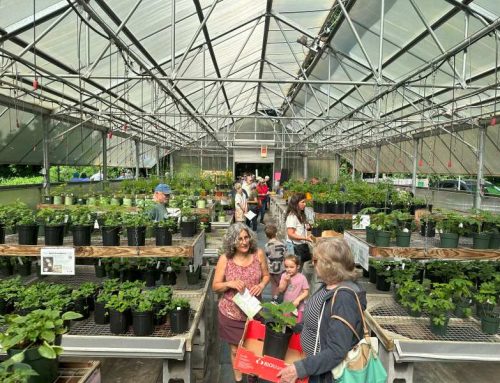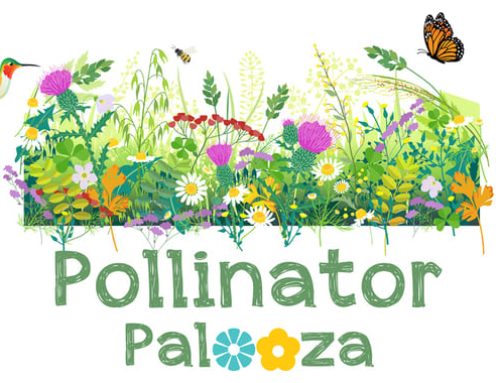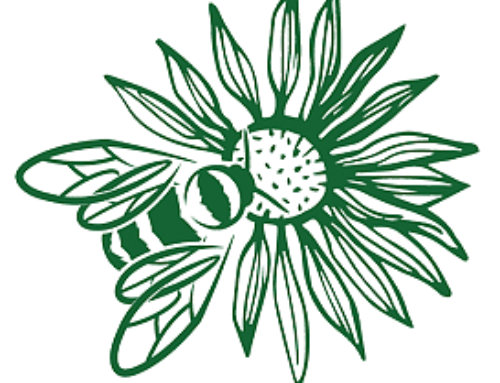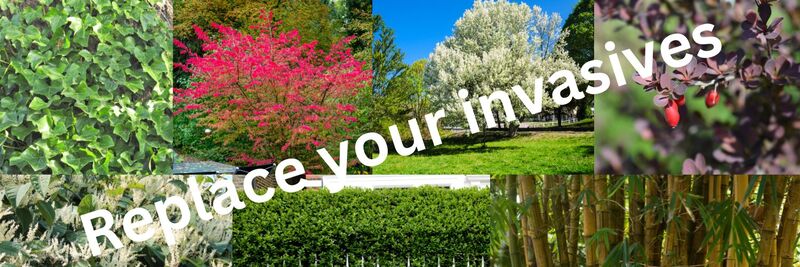
The Garden Club of America has proclaimed April 2023 Native Plant Month. Take a look around your yard and garden as they wake up from winter and identify invasive plants that should be replaced by natives.
Invasive species
These non-native species of plants spread and cause ecological or economic harm to their new environment. They adversely affect the food web by suppressing the growth of native plant species, which have co-evolved with native animals in the region and which are necessary for their survival. Not all introduced plants are invasive: many non-invasive exotic plants do not spread on their own or escape their plantings to outcompete native species. But even non-invasive introduced plants have low food value for our native animals compared to the plants that occur here naturally.
Keystone plants
These are the most important plants for wildlife and for maintaining biodiversity, in that they are major caterpillar and/or bee host plants. Caterpillars are the most important link in the food chain between plants and insect predators, like birds, ladybugs, and other insectivores. Native bees pollinate plants that provide food throughout the ecosystem, including food for humans. Keystone plants are different species in different parts of the country, but where we live, in the northern temperate forest, the keystone species are listed in this downloadable guide from the National Wildlife Federation’s Garden For Life program.
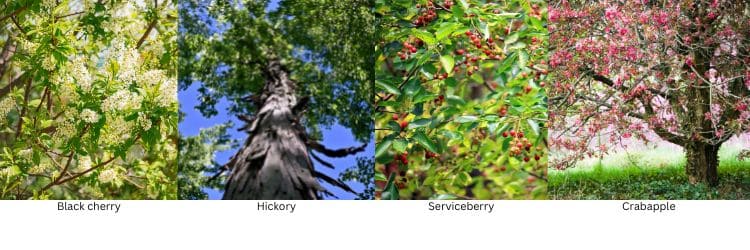
To support and conserve our wildlife, including birds and insects, it is important to plant keystone species and to get rid of invasive plant species in our roadsides, waterways, woods, and backyards.
Most invasive species are introduced by humans, including some common plants that people use in landscaping because they are pretty with showy foliage or flowers. Many of us have invasive species of plants in our yards.
This growing season, please do not plant the following species and please consider replacing the invasive species on your property with native keystone species suitable for our region. Even if you are not replacing an invasive, work some keystone species into your landscaping plan to maintain and strengthen the local food web. Not all of the plants listed below as alternatives to invasives are considered keystone species, but all are native plants that look similar to the invasive listed and provide food to native wildlife. If you want birds in your yard, plant keystone flowers, bushes and trees that will help feed them.
The following is a partial list of damaging invasive plant species commonly found in yards in this part of New York State. If you have an invasive tree in your tree lawn (aka hell strip, or right-of-way: the strip between the street and sidewalk) owned by the city or village in which you live, contact your public works department to find out options for removal of the invasive and replacement with a native keystone tree species, like a white oak, river birch or black cherry. Although trees can be expensive to remove, the ecological damage invasive trees are causing makes the investment well worth the expense.
Highly Invasive Species to Replace
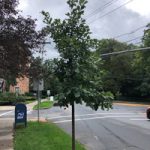
Native: Swamp white oak
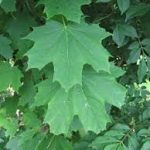
Invasive: Norway Maple
Norway Maple– These common street trees were planted in past decades by the city of Saratoga Springs in tree lawns all around town. They outcompete native maples because the seedlings are shade tolerant and the trees grow a dense canopy, blocking out the light to the understory. If you break a twig, the Norway maple has a milky sap that distinguishes it from native maples. Replace it with a native keystone shade tree, like a white or black oak, a black cherry, a hickory or a native maple tree.
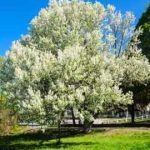
Invasive: Callery pear
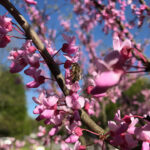
Native: Redbud
Bradford or Callery Pear Tree – These commonly planted invasive trees have a profusion of white blooms early in the spring with a distinctive and unpleasant odor. Birds are attracted to them as an early food source so they spread their fruits and seeds into forests, where they outcompete native trees and severely reduce biodiversity. They are so invasive in the southern part of the US that some states offer replacement trees free of charge to homeowners who cut them down. Replace with other early blooming native tree species like redbud, native plum or crabapple.
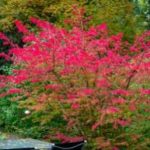
Invasive: Burning bush
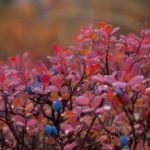
Native: Blueberry in fall color
Burning Bush – The bright red bush with the squared stems that you notice all over Saratoga in the autumn is the highly invasive burning bush. It is remarkably hardy and spreads rapidly by underground roots and shoots and is carried into woods and fields by birds that eat the berries. It takes over quickly, outcompeting native species. Replace it with highbush blueberries, oak leaf hydrangeas, choke berries or serviceberry.
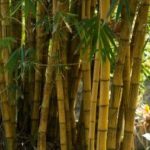
Invasive: Bamboo
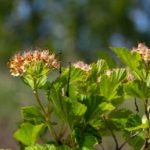
Native: Ninebark
Running Bamboo – This type of bamboo, as contrasted to clumping bamboo, spreads through underground rhizomes and can quickly establish a dense stand that strangles out any other plants in the area, thus creating what is known as a bamboo desert. Once it gets established, it is hard to control. Replace it with a serviceberry or ninebark hedge in your yard.
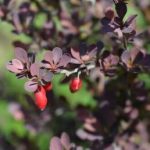
Invasive: Japanese barberry
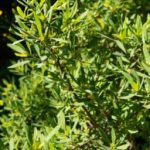
Native: Northern bayberry
Japanese Barberry – This small dense bush used in landscaping spreads through seed dispersal by birds and mammals and through underground roots. It outcompetes local vegetation, partly because deer won’t eat it. Replace it with highbush blueberry or northern bayberry.
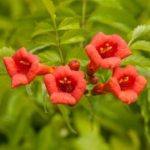
Native: Trumpet vine
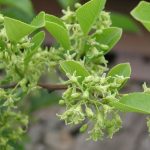
Invasive: Oriental bittersweet
Oriental Bittersweet – This beautiful vine was cultivated for autumnal flower arrangements but has now run amok all over the Northeast. It chokes out trees, shrubs and other vegetation and can be so dense and heavy that it actually uproots trees. Tear it out if you have it and plant American bittersweet, Dutchmen’s pipe or trumpet vine instead. Good luck getting rid of it, it can take several seasons of concerted effort.
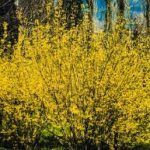
Invasive: Forsythia
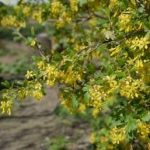
Native: Golden currant
Forsythia – Alas, the glorious yellow forsythia is in fact an invasive species, spreading by laying down canes on the ground that take root, creating a forsythia thicket that outcompetes native species once it escapes from your garden. Forsythia is an early bloomer and attracts bees, but it is sterile and does not make pollen so it is not a food source for them. Give the bees something to eat by planting a different early blooming shrub like spicebush or golden currant.
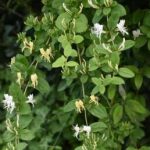
Invasive: Japanese honeysuckle
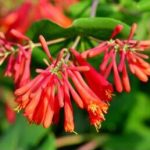
Native: Trumpet honeysuckle
Japanese Honeysuckle – This extremely vigorous perennial vine forms dense mats that outcompete native honeysuckles and other vegetation. It endangers trees by wrapping around the trunks and girdling them and by climbing into the canopy and blocking light and weighing down and breaking the branches. Replace it with native trumpet honeysuckle.
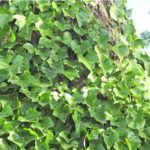
Invasive: English ivy
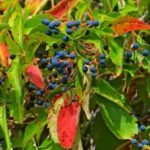
Native: Virginia creeper
English Ivy – A common, pretty vine widely used as ground cover, it spreads quickly and chokes out trees and other plants, outcompeting and killing them within a season. It should never be planted, but if you have it, pull it out and replace it with a native vine like native trumpet honeysuckle (not Japanese honeysuckle, that is also an invasive), Virginia creeper or American (not Asian) wisteria.
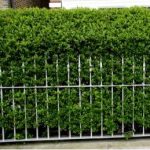
Invasive: Common privet
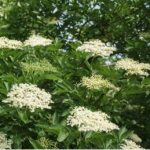
Native: Elderberry
Common (European) or Chinese Privet – This popular, fast-growing hedge plant is invasive because it is readily adaptable to all kinds of light conditions and because it spreads both by windborne seeds and by underground root suckers. Replace it with serviceberry trimmed into hedges, native viburnum or elderberries.
Japanese Knotweed
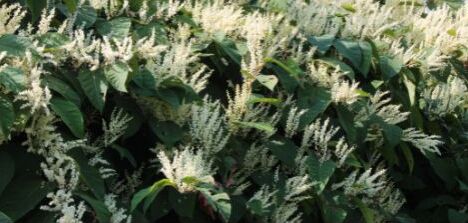
Invasive: Japanese knotweed
Although it is not sold in garden centers, there is also a lot of Japanese knotweed in the region. If you have it, please, please get rid of it and replace it with a keystone species. It is notoriously difficult to get rid of and spreads rapidly. Consult with your local Cornell Extension office for help.

If you’re not sure if what you have is invasive, try using a plant identification app such as iNaturalist by National Geographic. Snap a photo and it will give you information, including native range for most plants, trees, and shrubs. Invasives captured in the app are picked up by various groups that track their locations.
When you find invasive species, you can report them via the iMapInvasives app. The organization provides self-guided and webinar training for recognizing invasive species and using the app.
For more information on invasive species in New York
Contact your regional PRISM (Partnership for Regional Invasive Species Management) office https://www.capitalregionprism.org/
Contact Saratoga County Cornell Cooperative Extension: Phone: 518-885-8995; Email: saratoga@cornell.edu. Find other CCE office contact info here: https://cals.cornell.edu/cornell-cooperative-extension/local-offices
For more ideas on alternative native species to plant see:
Native plant finder from the Native Plant Trust
Invasive ornamental plant alternatives from Cornell University
Grow This, Not That: 12 Native Alternatives to Invasive Plants from Bob Vila
Alternative Species from Grow Native
Regional Picks: Alternatives to Invasives – Northeast from Fine Gardening
Ready to choose and plant a native tree? Download Sustainable Saratoga’s guide to recommended species and where to buy them and check out our Practical info for tree planting and care ![]()

